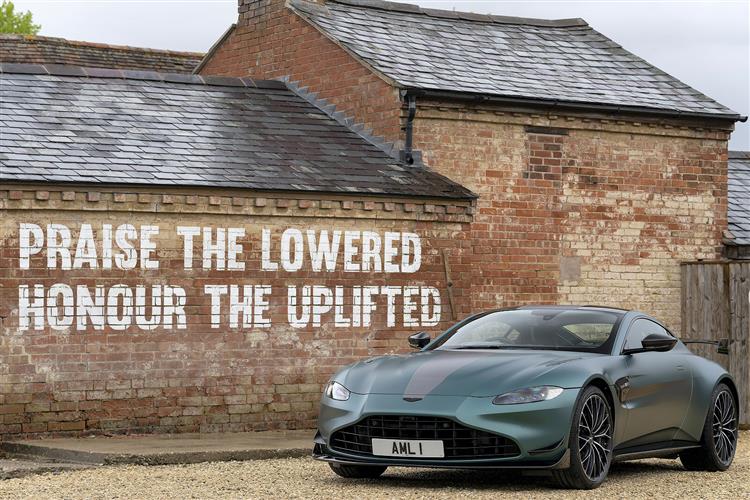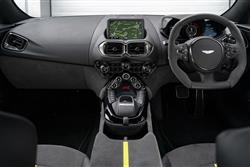How will you view?
This is a sample, showing 30 seconds of each section.
MORE ADVANTAGE ASTON (some text hidden) SECTIONED_new_astonmartinvantage_2022
By Jonathan Crouch
Introductionword count: 170
Vantage. An evocative name for a magnificent bloodline of thoroughbred sports cars. For seven decades, the heartbeat of Aston Martin's purest models, the Vantage nameplate has been worn by some of its most memorable designs - and the modern-era model launched in 2018 was another of them. In 2020, Aston lightly upgraded the car at the same time as introducing a Roadster convertible version and a more powerful 'F1 Edition' variant. It's that post-'20-era updated version we look at here from a used car perspective, which sold until a more far-reaching model upgrade in 2024. If you think you know what an Aston is and can be - and you haven't tried the Vantage in the form we look at here, then you might need to think again. As with the brand's other models, you might still buy it because of the way it looks or because it makes you feel like James Bond. We think though, that you'll simply want one because it's a very, very good sports car.
Modelsword count: 4
5-door GT [4.0 V8]
Historyword count: 601
If you can't afford that top end exotic supercar, Aston Martin's post-2018-era generation Vantage could be the next best thing. In fact, it may even be better. And here we're going to find out why. There was a time late in the last century, when 'Aston Martin' meant something very different. An iconic British brand, to be sure, but a maker of hand built sports cars aimed at older buyers romanced by name and heritage in the face of compelling evidence that German and Italian rivals were better made and finer to drive. The gorgeous DB11 of 2016 was a sign that the future might be different, but it was still an old-style GT, rather than an out-and-out sportscar, the kind of design still most likely to appeal to old school Aston enthusiasts. A slightly smaller model with a younger, more dynamic orientation was needed. A car that someone with little prior interest in the brand might buy. A car you could seriously choose over a top Porsche 911 or a Mercedes-AMG GT. A car like the modern-era version of Aston Martin Vantage launched in 2018. Prior to this introduction, for seven decades, the Vantage nameplate had been the heartbeat of some of Aston Martin's purest models and was first used in 1951 on a high-output engine option for the DB2. The Vantage quickly became a model in its own right, history highlights including the William Towns-designed V8 Vantage of 1977 and a spectacular twin-supercharged V600 Le Mans model. Most familiar in the heritage line for potential customers though, will be the car the 2018-era version replaced, the V8 Vantage first launched in 2005. That was the first modern-era Aston to really catch the attention of the company's German and Italian rivals, being relatively light, fast on its feet and desirably styled in both its coupe and Roadster guises. But both the V8 and V12 variants sounded faster than they actually were, build quality was patchy and the old fashioned VH chassis precluded the car from being able to match its competitors on track. Astons never have been able to do that; turn up to a track day in one and you'll be almost a celebrity, so rarely is the brand usually represented But this post-'18-era model proved to be different. Modelled unapologetically on a Porsche 911 and sharing its V8 twin turbo engine with a Mercedes-AMG GT, it was wilfully different from the brand's other models, not only in the way it looked but also in the way it handled. It was the most serious driver's car the company had ever made. There were questions though. It was slightly heavier than its 911 arch-rival. Plus, being over 20% more expensive than the outgoing model, this car no longer had the significant price advantage over its immediate competitors that its predecessor had enjoyed. And some buyers wondered if they should care that its engineering borrowed so much from directly competing class contenders. These were all good questions. But in the two years following its launch, this new-era Vantage proved very effective at answering them. Especially when Aston introduced a minor upgrade in 2020, creating the version of this car we're going to look at here. As part of this update, the range expanded, first with a Roadster convertible version and then with an even more powerful F1 variant. A limited-run Vantage V12 Coupe model followed in 2022, The Vantage sold in its updated Coupe and Roadster forms until early 2024, when more substantial range upgrades were introduced. Let's check out the used proposition offered by 2020-2023 versions of this rejuvenated Vantage.
What You Getword count: 467
This modern-era Vantage was launched in 2018 in Coupe form, then two years after, an open-topped Roadster version arrived. By 2020, for Coupe and Roadster customers, there was the alternative of a more powerful 'F1 Edition' version, recognisable by its larger 21-inch wheels, carbon fibre detailing, a unique vaned grille design and a substantial aero package including a bigger rear wing. In all its forms, this Vantage makes a statement, particularly at the front end which is dominated by the lowest-sited functioning grille every to have been used on one of the company's cars - and surely also one of the largest. In profile, you're reminded again that this post-'18-era Vantage shares nothing but its name with its older predecessor. It doesn't share much with its DB11 showroom stablemate either, apart from the all-aluminium chassis it rides upon - and even here, 70% of the structural components are different in this model. Our favourite Vantage point though, is at the rear, which is dominated by this pencil-thin LED lighting strip and an aggressively-angled lower diffuser, which helps to generate 50kgs more downforce than the previous model could offer. There's much to like once inside. It's a cockpit that shrinks round you far more than it does in a DB11 - as you'd expect it might given this Vantage's 101mm reduction in wheelbase. You sit 10mm lower than you did in the previous pre-2018-era model - which helps with the immersive feel - and grasp a flat-bottomed race-style stitched wheel, complete with huge aluminium paddle-shifters. Through it, you view a single-dial instrument binnacle, the colours of which change depending on drive and suspension mode selections made respectively via tabs on the right and left wheel spokes. An 8-inch Mercedes-sourced infotainment screen might look like an iPad hammered into the dash, but it works well enough and the fit and finish just about meets the exclusive standard required of an exotic super-sports car of this price. The triangular layout of the transmission buttons works well and there are lovely touches like the beautifully-crafted footwell kneepads and the saddle-leather door pulls. Storage space is at a bit of a premium, but you can at least reach back to the provided boot shelf, which tries to compensate for the lack of the useful little rear pews you'd get in a DB11 or (perhaps more pertinently) in a rival Porsche 911. That 911 would give you boot space at both ends of the car; you don't get that here, but the 350-litre luggage area capacity is vastly better than you'd get from, say a rival Audi R8 or McLaren 540C from this era. You're still going to have to pack with squashy bags rather than big suitcases but there's enough room here to make trans-Continental GT motoring a far more realistic option.
To see the full road test text contact us on 0330 0020 227
Pictures (high res disabled)

.jpg)
|
.jpg)
|
.jpg)
| |||
.jpg)
|
.jpg)
|
.jpg)
| |||

|
Scoring (subset of scores)
Category: Sporting Cars
| Performance | |
| Handling | |
| Comfort | |
| Space | |
| Styling, Build, Value, Equipment, Depreciation, Handling, Insurance and Total scores are available with our full data feed. | |





